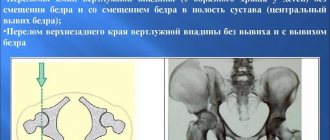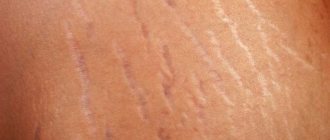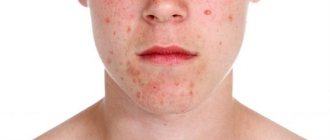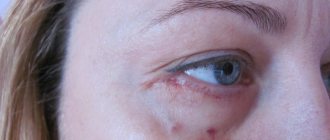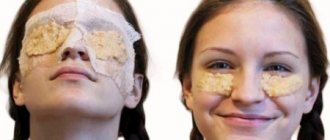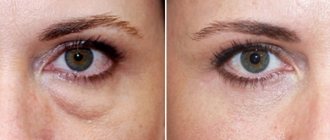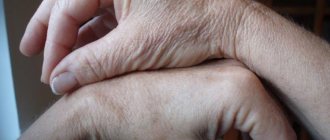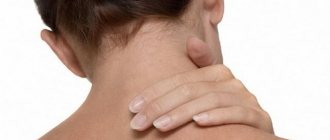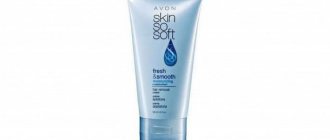Stretch marks or stretch marks are characteristic small scars that can appear on various parts of the skin. One of the main places where stretch marks are localized is the buttocks. The lack of collagen protein, which gives the skin elasticity, leads to the fact that in places where there is strong stretching, the skin becomes thinner, resulting in tears in the epidermis. The body, trying to restore the skin at the site of microtrauma, replaces healthy tissue with scar tissue. As a result, stretch marks appear, particularly on the buttocks. Women are usually susceptible to the formation of such stretch marks. However, stretch marks on the buttocks can also appear in men and children...
What are stretch marks?
Stretch marks or stretch marks are skin imperfections in the form of lines or stripes that are localized in areas of greatest stretching of the skin.
Favorite places for stretch marks are the legs, breast skin, buttocks, abdomen and thighs. With accompanying hormonal changes, stretch marks may appear on the face. Fresh damage to the dermis has a red-violet or pink color; over time, the stretch marks lighten or become discolored. In an advanced stage, stretch marks externally become like scars, which cause internal discomfort and uncertainty.
Ablative and non-ablative fractional lasers for the treatment of stretch marks
For many years, there has been a debate between manufacturers of fractional lasers about the effectiveness of their use for the treatment of stretch marks. Ablative and non-ablative fractional lasers trigger similar biological processes in tissues, which result in remodeling of the skin surface and smoothing of stretch marks. Since striae is a dermal formation, its correction requires thermolysis at the level of the dermis - lasers that reach the depth of the reticular layer of the dermis will be effective. The first, and most important, difference between lasers is the damage or, conversely, preservation of the epidermis. Ablative lasers “evaporate” all cells in their path without exception, and the activity of non-ablative lasers is configured so that only the dermal level is damaged without damaging the surface tissues - the epidermis. Ablative lasers are much more aggressive than non-ablative lasers and have a greater stimulating effect than the latter. Therefore, with all other parameters being equal (depth of exposure, percentage of coverage), an ablative fractional laser will be more effective than a non-ablative one, especially for CO2 lasers. However, the use of ablative lasers in areas where stretch marks are localized is fraught with discomfort and the development of complications. During rehabilitation, which takes from 3 to 5 days, it is necessary to protect the treated surface with a sterile bandage and avoid friction with clothing. The use of ablative fractional lasers on the body - in the abdomen, chest, hips - often ends in the development of post-inflammatory hyperpigmentation - an unpleasant, although temporary, phenomenon. Another disadvantage of fractional ablative lasers, in addition to complex rehabilitation, is rupture of striae due to incorrect procedure technique, which results in the formation of scars. This complication may be due to the fact that ablation microzones formed in the atrophy zone at the site of the striae make it weak to rupture, and subsequent stretching can provoke such a rupture.
RICE. 3. A - BEFORE TREATMENT, B - 2 MONTH AFTER 1 PROCEDURE OF NON-ABLATIVE FRACTIONAL PHOTOTHERMOLYSIS M22‑RESURFX. Photos in Fig. 3 and 4 kindly provided by Dr. E. L. Baranova.
RICE. 4. A - BEFORE TREATMENT, B - 1 MONTH AFTER 1 PROCEDURE OF NON-ABLATIVE FRACTIONAL PHOTOTHERMOLYSIS M22‑RESURFX.
RICE. 5. STREAMS IN THE BREAST AREA. A - BEFORE TREATMENT, B - AFTER 3 PROCEDURES OF NON-ABLATIVE FRACTIONAL PHOTOTHERMOLYSIS M22‑RESURFX. Photo courtesy of Dr. Matteo Tretti Clementoni.
Thus, we can say that non-ablative fractional lasers, despite their lower efficiency compared to ablative ones, are more preferable in the treatment of stretch marks. Classic non-ablative fractional lasers for the treatment of striae are Fraxel 1550 nm and ResurXF 1565 nm (Fig. 3-5). Both of these lasers are capable of creating zones of fractional photothermolysis 1 mm or more deep and are excellent for use on the body as they do not disrupt the skin barrier functions.
Causes of stretch marks
The mechanism of stretch marks is caused by hypersecretion of cortisol, leading to thinning and rupture of collagen fibers. Internal microtraumas contribute to the proliferation of connective tissue, which is why scars form.
The reasons for the formation of stretch marks can be different:
- hereditary factor;
- low elasticity of the dermis;
- poor nutrition;
- insufficient amount of water consumed;
- puberty;
- pregnancy period;
- sudden weight loss or gain;
- intense sports activities;
- diseases of the endocrine system and pancreas;
- long-term use of steroid hormones.
Also, stretch marks can appear throughout the body in patients with Itsenko-Cushing syndrome.
ethnoscience
Traditional medicine provides answers to almost any question - how to maintain youth, how to deal with skin imperfections and even overcome serious illnesses. Striae are no exception - there are many tips on how to remove stretch marks on the hips:
- Homemade scrubs. Honey-coffee scrubs are a compromise between massage and salon peeling. They exfoliate dead skin cells well and help destroy the connective tissue of stretch marks.
- Homemade wraps. It is most often recommended to use grape puree as a composition. Otherwise, the procedure is similar to the salon procedure, except that you will have to do the wrap yourself.
- Homemade cream for stretch marks. There are many recipes for such creams, but they have the same principle - mix solid, base and essential oils.
Pros : Most recipes contain simple ingredients that can be easily found in stores. You do not need to pay extra for specialist services or travel to the salon. In addition, all these procedures are pleasant and delight you with the aromas of fruits and essential oils.
Cons : The main disadvantage is one - the effectiveness of traditional medicine recipes is very doubtful. If you have fresh stretch marks, the chances are high that after scrubbing and supporting with vitamins, the skin will cope with the shortcomings, but old stretch marks are unlikely to be overcome. In addition, some home procedures can be dangerous. For example, using a homemade scrub can damage your skin.
How to remove stretch marks?
Treatment of stretch marks is a difficult and lengthy process that requires a professional approach to the problem, followed by a comprehensive course of manipulation.
By contacting Dr. Korchagina’s clinic, dermatocosmetologists will conduct the necessary diagnostics and select procedures:
- dermabrasion - a technique consisting of mechanical grinding with removal of skin layers; manipulation not only reduces the visibility of stretch marks, but also restores the structure of epidermal tissues;
- microneedle RF lifting INFINI - an innovative rejuvenating technology that causes tissue coagulation and collagenogenesis through the use of a fractional microneedle system;
- chemical peeling is a manipulation based on the application of strong organic acids to the stretch marks, which burn the epidermis and promote the synthesis of its own collagen fibers;
- PRP plasma therapy Regenlab - cellular rejuvenation of the skin through microinjection of its own purified and enriched plasma; plasma lifting stimulates the work of fibroblasts, and also promotes the production of elastin and collagen;
- facial mesotherapy – injection of meso-cocktails provides deep hydration and restoration, accelerating metabolism and nutrition of damaged skin;
- thermolifting – a hardware technique using the Palomar StarLux 500 laser machine improves blood circulation, metabolism and lymph flow; due to which the skin is regenerated and straightened.
Massage
Dry massage with special brushes - drybrushing - gives an excellent result in the fight against stretch marks. With regular use of such brushes, the skin is cleansed of dead particles, becomes smooth and soft, cellulite and stretch marks become less pronounced. The main rule of dry massage is that movements should be in the direction of the lymph: from the feet to the heart.
Dry massage is easy to perform yourself at home - the whole process will take no more than 15 minutes. Brushes make the skin elastic and well-groomed, and also relieve stress, relax muscles and activate recovery processes.
For a massage to be effective, it is important not only to do it correctly, but also to choose a quality brush. ARAVIA accessories are made of beech wood and natural bristles. Natural materials will make the procedure tactilely pleasant, and the long handle will allow you to work on hard-to-reach areas.
Brushes vary in degree of hardness:
- soft, suitable for beginners and those with sensitive skin;
- The medium one will appeal to those who have already tried drybrushing and want a more intense effect on the skin.
Remember: any massage technique requires prior consultation with a specialist.
>> We tell you how to do drybrushing correctly in the article “Massage with a dry brush: technique, tips and contraindications”
Prevention of stretch marks
To reduce the risk of stretch marks, you must follow several preventive recommendations:
- Include foods rich in omega-3 acids in your diet (fatty fish, walnuts, flaxseed, chia seeds).
- Get enough vitamin D.
- Limit the amount of sugar and sweets you consume.
- Eat more fresh vegetables and fruits.
- Drink at least 8 glasses of clean drinking water a day.
- Monitor weight gain during pregnancy.
- Use moisturizing creams and body lotions.
- Do not abuse the use of corticosteroids and anabolic steroids.
- Stop smoking.
- Exercise regularly.
- Visit a nutritionist and cosmetologist in a timely manner.
make an appointment with a dermatocosmetologist at the Korchagina Clinic in Moscow from the consulting manager on the website or by phone.
Creams and gels
The main difference between store-bought creams and homemade creams is that the ratio of ingredients in them is precisely adjusted, and numerous tests have made it possible to obtain a truly effective and safe composition. In addition, some active substances will be very difficult for you to obtain on your own. For example, FERMENCOL® brand products contain an extract from crab liver. Agree, it will not be so easy to get it!
When choosing a suitable cream or gel, it is important to understand the purpose of the product. Here are some of the main types of products to combat stretch marks:
- Preventive . For example, creams and oils used during pregnancy to moisturize and increase skin elasticity. However, they will not affect existing stretch marks after childbirth.
- Remedies for fresh stretch marks . They are effective if the stretch marks on your thighs have not yet turned white.
- Remedies to combat old stretch marks . Such gels and creams contain active ingredients that allow you to cope even with old stretch marks that appeared more than a year or even several years ago.
Pros : Creams, oils, mousses and gels for stretch marks are the most budget-friendly of all the options that can be called effective. With the right product, you can deal with both fresh stretch marks and old ones, without trips to the salon or traumatic procedures. This is especially true for young mothers who cannot afford to leave home often and for a long time, but want to quickly return their skin to a healthy appearance.
Cons : It is very important to choose the right product and follow the instructions exactly . If a specialist does everything for you in the salon, then you need to approach the process yourself with full responsibility, do not skip procedures and apply the cream or gel within the prescribed period. Sometimes, to increase efficiency and speed up the process, the use of additional devices is required, but the good news is that they are not too expensive and are available for free sale.
Before you get rid of stretch marks, learn more about them
Striae appear in areas where the most fat accumulates: abdomen, thighs, buttocks, chest. The cause of stretch marks is a disruption in the production of collagen and elastin fibers. They are responsible for the flexibility, plasticity of the skin, its adaptation to new forms.
Stretch marks on the body appear with sudden weight gain. The skin does not have time to create fibers, and some areas “burst.” In their place, purple, bluish spots form. Over time they fade to white stripes. Striae vary in size and texture. For some they are almost invisible, and for others they look like scars.
It is a fact that many women and men suffer from them. This is a purely cosmetic defect and does not cause any health problems.
Myths about striae:
- They may go away on their own. No, the reddened area of the skin may turn pale so that it becomes invisible or have a microscopic size and be almost invisible. But the structure of the site itself has already been damaged. The properties of stretch marks are similar to scars.
- Appears only on dry skin. And if you moisturize your skin, for example, during pregnancy, then stretch marks on your stomach will not appear. This is wrong. People with any type are susceptible to stretch marks.
- Stretch marks on the chest and abdomen only occur in women. It is true that one of the reasons is hormonal imbalance, but it also happens to men. In addition, stretch marks are common among athletes and bodybuilders who build muscle mass too quickly.
- There are special cosmetics that will help get rid of stretch marks on the skin. No, it's a myth. Whitened stretch marks can be removed without a trace only with medical help.
“I'm afraid of myself. I have 28 stitches on my hip.” Photo stories of people who are addicted to self-harm
return to section
May 18, 2019
5795
Self-harm is also called a type of auto-aggression and self-harm. By mistake, many people consider self-harm to be creepy entertainment for teenagers or a manifestation of the insanity of adults. In fact, self-harm is most often an attempt to get rid of anxiety, fear, self-hatred and guilt. Selfharm can be provoked by the consequences of severe mental trauma and depression. There is a myth that only people who cut themselves are those who want to attract attention to themselves - we found heroes who deliberately hurt themselves and learned their motivation.
Tim. “I just sat and cut myself with a knife - and I felt good.”
“I have scars on my thighs and on my arm. I cut myself with broken glass, blades and stationery knives. The first scars were made with broken glass. I started doing all this for no reason, I just liked it. As a teenager, I walked through abandoned buildings with glass lying everywhere. I liked to peel off my skin with a flat glass. I was about fourteen years old then. My friend was worried about the situation in her family and wanted to cut herself, but was afraid. And I told her that there was nothing scary about it - and I cut myself, convincing her that there was nothing painful about it. I had a detrimental effect on my friend, although it seemed like support to me at the time.
The thighs have the most scars; they were all inflicted two years ago due to a turning point in my life. Then I found a job and wanted to move away from my mother. But I had no experience of how to rent an apartment, how to pay utilities, what to cook, how to buy groceries. I slept at work, slept in parks, slept in an apartment with the ashes of a friend’s dead grandfather. At that time I had problems in my personal life - my boyfriend left me, and in addition, a large sum of money was stolen. The last step for selfharm was breaking up with the guy. We dated for three years, we had a large number of joint affairs, I believed that we had one life for two. But sometimes feelings are deceptive. Everything collapsed at once. A week after the breakup, I cut my legs. The world was collapsing, something had to be done. I just sat and cut myself with a knife - and it felt good. I even like the tingling pain after them.
Six months passed, I began to experience severe aggression towards myself. It seemed that I began to come to my senses, that I was able to do many things, but I lost my desires. I woke up to the alarm, forced myself to turn off the alarm, and even hit myself in the face. There was no motivation to do anything at all. But inside there was a stubborn confidence that all this would pass. I began to set goals, forced myself to do ordinary things: learn English, take photographs, draw. Later I realized that I could not communicate normally with everyone, although I wanted to become a more sociable person. An inner voice said that I was doing everything wrong, that I needed to punish myself. Then there was a second wave of cuts, more severe - so severe that they almost filled the apartment with blood. I filled it with peroxide, treated it - and all is well.
My self-harm is not at a constant level, it comes in waves. I can’t call it a habit, but I don’t deny that I’ll probably do it more than once. She did not resort to the help of doctors. I always tell myself that everything is fine with me. I really think I'm doing well. I see people who are abnormal. These people usually do not have the strength and will to cope. I'm succeeding so far. To be honest, I think people often cut themselves because they have a lot of free time. I don't do this to attract attention, I don't like it when people pay attention to me. I chose legs because I always wear trousers so no one will see them. I understand that when people see my scars, they will begin to pay attention and judge. And no one likes condemnation, neither do I. I do this for myself and consider self-harm a personal matter for everyone.”
Ksenia. “The deepest scar I have is on my thigh, 28 stitches.”
“My auto-aggression began at the age of nine, there was a difficult relationship between my mother and father, I was a witness and participant in their conflicts. Because of my strong emotional involvement in their quarrels, I pulled out my hair and scratched my face. When my father died, I stopped doing this for a while. But at the age of 16, I had major problems with my mother and quarrels with my brother, who beat me. I defended myself as best I could, but my mother took my brother’s side and did not react to me in any way. That was the first time I cut myself, it was with a blade. During the next conflict, I ran to the bathroom and cut myself. I felt better psychologically; physically, sometimes I felt pre-fainting.
Sometimes I couldn’t even crawl to the bed, even though there was only a little blood. And sometimes I feel good. At first, self-harm was a rare occurrence; I managed it myself. Then the scandals escalated - and I began to seek help from a psychologist. I typed “I hate my brother” into the search engine and began to correspond with a psychologist from Russia, who accused me of provoking my brother. He explained this by saying that he and his sister have a similar relationship, since she provokes him. I began to cut myself very often - “covered” with or without reason. For example, I was late for somewhere - and I was so worried that if I had a blade with me, I would have cut myself. And if not, then she pulled out her hair, bit her hands, and scratched her face. This is how all situations that caused tension in me were resolved. Self-harm became a habit.
Even when I left to live with my mother and my sister, the habit remained. Every year it gets worse, sometimes I'm very scared. I'm afraid of myself. My injuries are so deep that it's scary. I have a medical education, I often help people, I can provide first aid and stop bleeding. But I treat myself completely differently.
I cut my thigh - this is the deepest scar I have, 28 stitches. I was visiting my sister then. She was sitting in the kitchen with a friend and drinking tea, and at that moment I was cutting my thigh in the bathtub. I cut it, did not process it in any way, put on my pants and went to bed. This morning I woke up and there was blood all over. My sister had already left for work, and I went to a psychiatrist - I went to a day hospital. The doctor asked if I cut myself today, I said: “A little bit.” She asked me to show her, and when she saw my thigh, she almost fainted. I called an ambulance - despite the fact that more than twelve hours had already passed, they still stitched up my wound. Now, being in the most stable condition, I am grateful to the doctor for helping me. I could have lost my leg or even my life due to infection. Now I remember and don’t understand how I could do this to myself. Not just cut, but go to bed and wake up covered in blood.
My brother said, “I want you to die,” “go out the window,” “if only you were hit by a car.” Mom also said emotionally: “We’ll pay you back once and that’s it.” I absorbed all this like a sponge and accumulated it within myself. Of course, I cut myself behind closed doors and only wore long sleeves. One day I went out with my sleeves open, and my mother saw the cuts. She asked where they were from, I shrugged it off and came up with another reason. She didn't say anything. But in the next quarrel, out of emotion, she called me crazy because I cut myself. She guessed, but remained silent. Mom doesn’t think that this is because of our relationship with her - she found another reason for herself, she decided that it was because of quarrels with her sister’s husband.
What scares me more is not the cuts, but the fact that I react so strongly to everything. Even if I don't cut myself, there are many other ways. For example, I put out cigarettes on myself, even though I don’t smoke. I bought cigarettes specially, took a couple of puffs and extinguished them on my skin. The condition itself, when it hits you, is worse than when you practice self-harm. But it’s very difficult to resist not doing this. I bite myself until I bruise, I hit myself in the face. The scar on my hand was also stitched up; I cut myself behind the cinema.
I try not to communicate with my brother. I love him from a distance, but I can’t see him yet. Mom calls me, cries, says she loves me. She says that children always fight, that this is the case in all families. She doesn't think that when my brother grabbed a knife or strangled me, it was beyond the bounds. She believes that my psychological state was affected by a traumatic brain injury received in childhood. But even doctors say that it is due to problems in the family.
I go to therapy, take antidepressants and antipsychotics. I would not have been able to cope without medication support. Yes, and you need to discuss with a doctor and psychologist why this happened, to look for the root cause. It's very difficult to cope on your own. I used to think that only teenagers practice self-harming. This is wrong".
Evgeniy: “Honestly, I wanted my parents to notice the scars”
“I have always been slightly emotionally unstable, and my parents, to put it mildly, are authoritarian. I was a very difficult teenager, I made frequent scandals, I just never left home because I had nowhere to go. The words “self-harm” and “self-harm” were completely unfamiliar to me.
Even as a child, it was normal for me to hit myself for the fact that something did not work out in the process of piano lessons. Or when I hurt a loved one because my emotions were out of control. I felt guilty and punished myself. It was absolutely normal for me to make a cut as a mark that I shouldn’t do that. The first cuts appeared in adolescence, and no one noticed them, or perhaps they simply did not want to notice. There was a period when I did start to get a reaction from people around me, but it was like, “Oh my God! What are you doing?
Friends were the first to notice, but parents stubbornly ignored it. Honestly, I wanted my parents to notice. They say that teenagers hurt themselves to get attention - often this is indeed one of the reasons. But this is not manipulation, they are in pain, they are not okay, and they cannot attract attention in any other way.
I first heard the word “selfharm” from my friend in my first year at university. By this point I had been practicing it for a long time. It turned out that there were friends who did the same and also did not know what it was. We did not perceive each other as deeply unhealthy people. For me it was some kind of ritual to take control of my emotions.
Selfharm is a habit. It often becomes a way to cope with anxiety and guilt. For me, it was absolutely normal to wipe the knife with an antiseptic in advance and run a lighter over the skin. It was such a calm habit that I even prepared for it.
Depression doesn’t just come out of nowhere either. I had problems in my family, there were episodes when I was severely beaten, when I lost a very close person. But when I went to therapy, they told me that in addition to these injuries, I had a whole bunch more to boot. It happens that a person does not feel connected to his body and may engage in self-harm in order to feel real.
I once wrote on Twitter that self-harm is not scary. People asked a lot of questions about what experts thought about it. Some people thanked me for talking about this. For those who are watching from the outside, I want to say: there is no need to wage an aggressive fight against self-harm. When an aggressive struggle begins, a person feels even more guilty, self-destruction begins, which again leads to auto-aggression. Vicious circle".
Anna: “This is a good signal that there is a mess going on inside me.”
“I have been living and studying in Belarus on my own for five years now. Now the educational part at the university is over, exams, diploma defense and an unknown future lie ahead. When I'm nervous, I pull out my eyebrows and eyelashes, rip off the cuticles around my nails and scratch off my polish. During a session with a psychologist, I learn to listen to myself and try to stop myself, ask myself questions: “What worries me so much and how can I fix it?” The psychologist once again reminds me to listen to myself, since what I do with my body is an indicator of my internal state and the answer to many questions.
Since I arrived in Belarus and started living an independent life, I have been experiencing a lot of anxiety. Here I had neither relatives nor friends. Friends and girlfriends began to appear only after a while, some of them lived with me in the hostel. But in moments of nervous tension, I still involuntarily begin to tear out my eyebrows and eyelashes. In five years at university, I never learned to take many things calmly. Now I’m learning to understand the causes of anxiety, I’m figuring out how not to bring it to such a state. I don’t paint my nails because I start to scratch the polish, and I stopped adjusting my eyebrows because they looked like strings. Now, if in a fit of anxiety I start tearing them out, the result is not as sad as before.
I can’t say that these manipulations harm my life. This is not harmful to health, but for me it is a clear signal that there is a mess going on inside. To calm down the chaos inside, I need to listen to myself and sometimes write everything down - plans, worries, doubts. I started going to therapy last spring, there were and still are plenty of reasons for this. One of them is independent living. I also start to injure myself when I have to perform. This also happens when you need to do work that you don’t want to do, but is necessary.
During the process I do not feel pain, rather I feel pleasure. For example, I love the feeling of pulling out several eyelashes at once. It's like a scab on a wound that you want to rip off. This is a need, a desire. I can’t say that this kind of self-harm bothers me, but I would like it if I didn’t have such a need, and that my hands and eyebrows looked aesthetically pleasing.
My anxiety comes from not knowing myself, from unconscious problems and from the unknown of the future. Now I have just as many reasons for anxiety, but I’m working through them better. Sometimes this means sitting down and detailing or talking through even trivial things. I think that thanks to therapy I am becoming more aware of how I manage my body and my life.”
Maria. “I control the location of the cut. If I do something serious, I’ll go to the hospital.”
“I started cutting myself at the age of fourteen, before that I was starving. The first couple of times I forgot to eat, I felt hungry - and I liked it. Thus, I drove myself to anorexia. There was no reason for this. When I was fourteen years old, the hype was about cutting - and I wanted to try it. I'm working with a therapist and she asks if I cut myself. Sometimes he looks at the cuts, sometimes he asks if there are new ones. In fact, she doesn’t care, she writes something for herself on pieces of paper, but she doesn’t care. I just come once a month for pills - that’s how a free psychotherapist works at the clinic.
In general, there is always a reason for cuts. Let’s say I’m quarreling with my mother, and to relieve stress, I cut myself. I have a difficult relationship with my family. Father doesn’t care about anyone, and mother didn’t care either. My father also killed my pet rat. He came drunk and approached her - she bit him, and he strangled her. This was my first pet.
Self-harm makes me feel better; I don’t see any problems with it. The appearance of scars doesn't bother me. My relatives saw my cuts, my father doesn’t care, my mother is sometimes indignant, and my younger sister scolds me and hits me on the head for it. I control my cuts and am confident that I won’t hurt my artery in any way. I control the location of the cut. I understand that if I do something serious, I will go to the hospital. Just being away from home is a nightmare for me. I have borderline personality disorder, and self-aggression is a symptom of it. Borderline disorder develops mainly with childhood traumas, such as neglect in the family, violence, rape. Self-harm is one of the features of my diagnosis, which also includes mood swings, impulsivity, and desocialization.
At times I work myself up to the point of self-hatred – and that’s why I cut myself. Or I cut myself because of a quarrel with someone. After finishing school, my father began to pressure me to go to work or enroll somewhere. Then, after a long break, the wave of cuts began again. I was nervous from the pressure, from not being able to get a job because I was only seventeen. At seventeen years old, finding a job is almost impossible. By the way, I got a job in a coffee shop, but I was a lot nervous and mentally tired. Too much contact with people and too much time away from home. I cut myself very often back then. Now my plans are to improve my languages and try to find a way to support myself as a freelancer in order to interact less with people. But until I find an alternative to self-harm, I won’t stop cutting myself, because it makes me feel better.”
KYKY.ORG
